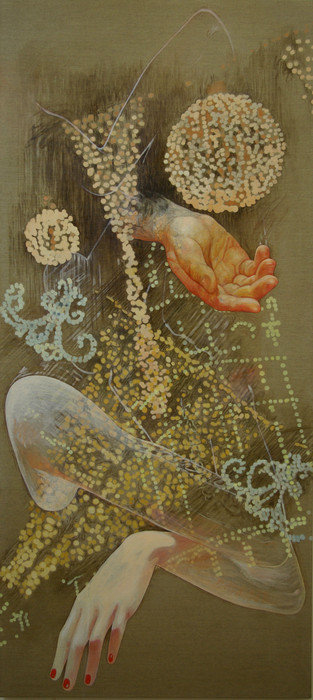Margarita Gluzberg
dal 30/4/2008 al 7/6/2008
Segnalato da
30/4/2008
Margarita Gluzberg
Paradise Row (old location), London
Comprising of paintings, drawings and a display of an eclectic range of books, printed matter and other ephemera, the show draws on autobiographical material from Gluzberg's Soviet childhood, historical images of the English industrial North, the glittering shop facades of Bond Street and pictures of trading floors.

This is money… this is greed… this is power… This is… In the Blackout
… the blue petals of Forget-me-nots sit, a pretty, ghostly, presence
on the surface of the canvas and behind an image of… what? Of, this…
of pure desire, ordered, corralled into regularised working hours,
into electronic information – light no less – that fills the hungry,
unblinking computer screens that chart, with ruthless relentlessness,
the fluctuating prices of every commodity in the world... This is…
Christmas Bollocks … particles of carbon.... an element born late in
the history of the universe… born in the heart of a dying star… once
coal black, now, compressed by weight, heat and time, they are
transmuted into sharp, clear crystals that glint from behind a
reflective screen of glass in which Christmas lights glitter in dark
moments… This is… Leeds Market... Edwardian iron structures that soar
upwards, conspiring to capture space from the sky in order to frame
the daily rituals of production, display and consumption… This is…
Coming with her Husband … two luxury crustaceans, two limpid, languid
langoustines, replete with lemon wedges… temptingly thrust towards
you…
Description property of Paradise Row…
‘If you think, from this prelude, that anything like a romance is
preparing for you, reader, you never were more mistaken. Do you
anticipate sentiment, and poetry, and reverie? Do you expect passion,
and stimulus, and melodrama? Calm your expectations; reduce them to a
lowly standard. Something real, cool and solid lies before you;
something unromantic as Monday morning, when all who have work wake
with the consciousness that they must rise and betake themselves
thereto.'
Chapter 1, 'Shirley', Charlotte Bronte
Paradise Row is proud to present The Money Plot a new exhibition by
Russian born, London based artist Margarita Gluzberg. Comprising of
paintings, drawings and a display of an eclectic range of books,
printed matter and other ephemera, the show draws on autobiographical
material from Gluzberg’s Soviet childhood, historical images of the
English industrial North, the glittering contemporary shop facades of
Bond Street and iconic pictures of trading floors, to piece together a
bio-fictional history of consumption and its effects.
The works plot a serendipitous course through an imagined, personal
history of the birth of modern consumer society. No clear thesis is
presented, no blueprint for resistance drawn up, instead Gluzberg
offers an empathic, response to the vast, vital energies of capital
flows that animate our world.
The title of the show is taken from an appendix of Balzac's novel La
Cousine Bette. The work’s editors decided that in order to understand
the complex network of the characters‚ relationships and intrigues in
the book, the reader must be provided with a synopsis they termed The
Money Plot - a breakdown of debts, financial dependencies and
connections between the protagonists. The Money Plot lies behind all
human relationships.
Private View: Thursday, 1 May 2008, 7-9pm
Paradise Row
17 Hereford St - London
Free admission



